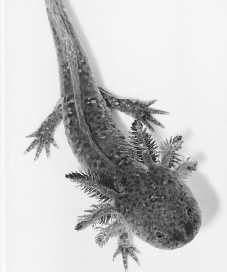
Gas
Exchange
 |
All animals have evolved some type of system or structures to handle
the
exchange of gases. The solutions are many and depend on the species and
its evolutionary history. The process may vary over the life cycle and
may depend on environmental conditions. Sometimes it is a relatively
simple
solution (e.g. in a jelly fish) while in other animals (such as in
vertebrates)
complex systems have evolved to handle the task. The ultimate cause of
all of these structures are linked to Cellular Respiration. This
process
needs oxygen to proceed (recall - oxygen is the final electron acceptor
in the electron transport chain). In addition, the same process
produces
an excess of carbon dioxide in the tissues. The excess leads to a
lowered
pH which can have grave consequences. In this chapter you will explore
the diversity of solutions to the problem of exchanging gases at the
same
time as you gain a deeper understanding of the process in humans. |
The following questions will
help you to review the material from the lecture, as well as the text.
Make sure to take a look at the links to the images and the web sites
at
the end of the page. I have also included suggested reading material in
case you would like to follow up on any of the aspects covered in this
section.
Review Questions:
-
Why is gas exchange a
necessity
(from a cellular perspective)?
-
Briefly explain the
process of
cellular respiration (include the following processes: glycolysis, the
Krebs cycle and the electron transport chain (ETC) in your answer)!
-
Where does the carbon
dioxide
originate from? Why does it need to be removed from the organism? What
will occur if the carbon dioxide accumulates within the organism?
-
What is the importance
of accessing
oxygen? What exactly is it used for? What happens if there is no oxygen
available?
-
The term 'respiratory
system'
is typically used to refer to the system involved in providing gas
exchange
for the organism. What is the main physical process that is used for
the
actual movement of the two gases? Can the respiratory system handle
this
process alone in a larger organism?
-
Why does the surface
area of the
exchange surface be large as well as moist?
-
How does the amount of
available
oxygen vary between aquatic and terrestrial environments?
-
What are the major types
of gas
exchange systems that have evolved in animals?
-
Describe the use of
external surfaces
(skin/epithelium) in gas exchange. Describe the actual process of gas
exchange.
Give several examples of animals that use this method. What is the
crucial
factor in terms of being able to use this type of gas exchange?
-
Are animals that use
external
surfaces for gas exchange restricted to that method? Give examples
animals
that combine several types of gas exchange.
-
Explain the concept of
gills in
animals. Is there a connection between gills and the circulatory
systems
in animals?
-
Give examples of several
different
types of animals with gills?
-
Make a drawing of the tracheal
system in an insect. Label important structures.
-
Describe the process of
gas exchange
in the tracheal system in the insects. How does the animal control the
level of gas exchange?
-
Describe the structure
of a book
lung as found in a spider (use a drawing).
-
What are the basic
characteristics
of a lung?
-
Where does gas exchange
occur
in a mammalian lung?
-
How does a bird lung
differ from
a mammalian lung? Briefly explain the process of gas exchange as it
occurs
in a bird lung.
-
Make a drawing of a
human lung
and label important parts in the upper as well as the lower respiratory
tract. What are the functions of the different parts?
-
How is it possible that
inhaled
air will be clean, humid and warm as it reaches the alveoli of the
lungs?
-
What is the importance
of the
alveoli?
-
Explain the process of
gas exchange
as it occurs between the alveoli and the capillaries in a human lung.
-
Why are the epithelia of
the capillaries
and the alveoli so thin?
-
Describe the structure
of lung
tissue as viewed in a light microscope.
-
Explain the process of
negative
pressure breathing.
-
What factors control
breathing
in a human? Where is the breathing control center located?
-
How is oxygen
transported with
in the blood? Describe the variety of proteins used in animals for this
purpose!
-
What is a heme group?
What is
its function?
-
There are different
forms of hemoglobin
(e.g. fetal versus adult hemoglobin). Explain!
-
How is carbon dioxide
transported
in the circulatory system? In which chemical form is carbon dioxide
transported?
Links:
Illustrations:
Lecture
Outline
Role
for
Intake
of gases
Transport
of gases
Tissue
cells
Respiratory
Surfaces
Types
Skin
Gills
Trachea
Lungs
Skin
Moist
surface
Link
to circulation
combined
with other system
Role
of surface area
Gills
Oxygen
in water
gill
structure
capillaries
in lamella
how
would gills do on land?
role
of countercurrent flow
Tracheal
System
Insects
Trachea
Spiracles
Air
sacs
Close
connection to cells
Compare
with gills and lungs
Lungs
Terrestrial
vertebrates
Frogs
Birds
Breathing
mechanism
Structure
Diaphragm
Pharynx
Larynx
Trachea
Bronchi/
Bronchioles
Alveoli/
Connection to capillaries
Smoking
and Lung Disease
Cancer
Emphysema
Breathing
Mechanism
Negative
Pressure breathing
Role
of diaphragm
Control
of Breathing
Control
centers
Link
to CO2
Increased
CO2 leads to lowered pH
Gas
Exchange in the body
Role
of red blood cells
Hemoglobin
Fetal
vs adult hemoglobin
Transport
of oxygen
(bound
to hemoglobin)
Transport
of carbon dioxide
(as
bicarbonate HCO3- in plasma)
Exchange
of gases between the human fetus and the placenta




